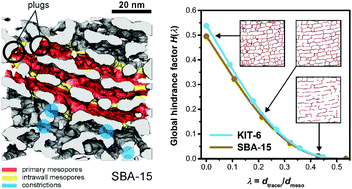Morphology–transport relationships for SBA-15 and KIT-6 ordered mesoporous silicas†
Abstract
Quantitative morphology–transport relationships are derived for ordered mesoporous silicas through direct numerical simulation of hindered diffusion in realistic geometrical models of the pore space obtained from physical reconstruction by electron tomography. We monitor accessible porosity and effective diffusion coefficients resulting from steric and hydrodynamic interactions between passive tracers and the pore space confinement as a function of λ = dtracer/dmeso (ratio of tracer diameter to mean mesopore diameter) in SBA-15 (dmeso = 9.1 nm) and KIT-6 (dmeso = 10.5 nm) silica samples. For λ = 0, the pointlike tracers reproduce the true diffusive tortuosities. For 0 ≤ λ < 0.5, the derived hindrance factor quantifies the extent to which diffusion of finite-size tracers through the materials is hindered compared with free diffusion in the bulk liquid. The hindrance factor connects the transport properties of the ordered silicas to their mesopore space morphologies and enables quantitative comparison with random mesoporous silicas. Key feature of the ordered silicas is a narrow, symmetric mesopore size distribution (∼10% relative standard deviation), which engenders a sharper decline of the accessible-porosity window with increasing λ than observed for random silicas with their wide, asymmetric mesopore size distributions. As support structures, ordered mesoporous silicas should offer benefits for applications where spatial confinement effects and molecular size-selectivity are of prime importance. On the other hand, random mesoporous silicas enable higher diffusivities for λ > 0.3, because the larger pores carry most of the diffusive flux and keep pathways open when smaller pores have closed off.

- This article is part of the themed collection: 2020 PCCP HOT Articles


 Please wait while we load your content...
Please wait while we load your content...